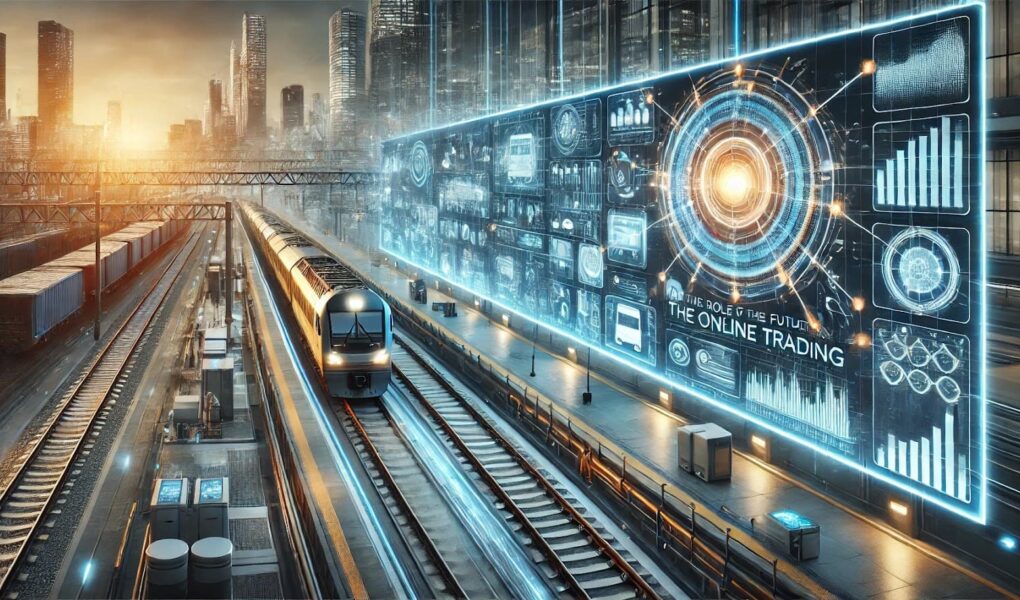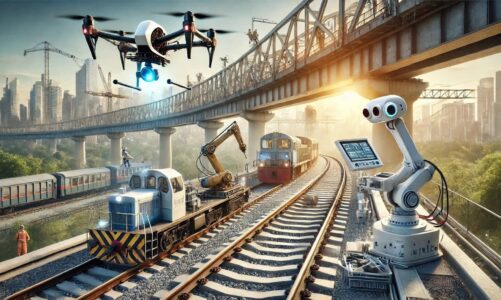Investing in the future of rail freight involves recognizing the growing role of technology and digital innovation in reshaping the logistics landscape. With the increasing demand for efficient and sustainable transportation options, rail freight is poised for transformation. Automation, IoT (Internet of Things), and AI are revolutionizing how freight is managed, allowing for real-time tracking, predictive maintenance, and optimized route planning. The integration of these technologies not only improves operational efficiency but also enhances safety and environmental sustainability. Moreover, the emergence of digital platforms is enabling a new era of online trading for rail freight services, offering businesses more accessible, transparent, and cost-effective ways to connect with logistics providers and shippers globally.
As online trading continues to expand within the logistics sector, platforms like Exness MT4 are becoming crucial tools for streamlining operations and driving the digital transformation of rail freight. These platforms facilitate seamless transactions, offering businesses the ability to manage their supply chains and monitor freight movements with greater precision. By enabling faster decision-making and access to real-time data, such digital tools are key enablers of efficient investment strategies in the sector. As more companies embrace these technological advancements, the future of rail freight will undoubtedly be shaped by a combination of innovation, connectivity, and smarter investments in digital infrastructure.
The Current State of Rail Freight
Rail freight continues to be a critical component of global supply chains, providing a reliable and efficient means of transporting goods over long distances, particularly in regions with vast landmasses like North America, Europe, and parts of Asia. Here’s an overview of the current state of rail freight, including key trends, challenges, and opportunities:
Sustainability and Environmental Impact
- Rail is one of the most energy-efficient modes of transportation, emitting fewer greenhouse gases (GHG) per ton-mile compared to road or air freight.
- Increasing focus on sustainability has driven investments in electric rail systems, as well as alternative fuels like hydrogen and biofuels to reduce emissions further.
Technological Advancements
- Automation and Digitization: The integration of technology into rail operations is enhancing efficiency, safety, and track management. Automated systems, predictive maintenance, and real-time data analytics are streamlining operations and improving decision-making.
- Digital Platforms: There is a growing trend toward digital freight platforms that allow for easier booking, tracking, and optimization of rail freight services.
- Internet of Things (IoT): Sensors and IoT devices are increasingly used for cargo tracking, providing real-time visibility and reducing delays or cargo damage.
Infrastructure Investment
- Many countries are investing in modernizing their rail infrastructure. In particular, the European Union has been heavily investing in cross-border rail connections, improving the efficiency of freight corridors.
- In North America, rail companies are modernizing tracks and equipment, and expanding capacity to meet growing demand.
Challenges in Rail Freight
- Infrastructure Bottlenecks: Despite improvements, aging infrastructure, particularly in certain regions, remains a significant hurdle. Many rail networks are still operating at or near capacity, leading to congestion and delays.
- Regulatory Barriers: Rail freight faces complex regulatory frameworks that can differ from region to region, leading to inefficiencies and delays at borders, especially in Europe.
- Labor Shortages: There is a growing shortage of skilled labor, particularly train operators and maintenance staff, which can impact the reliability of services.
- Competition with Road Freight: While rail is more efficient for long-distance transport, road freight is often more flexible, especially for short distances and last-mile delivery. The cost-effectiveness of rail depends on the volume of freight and the distance involved.
Economic Recovery and Increased Demand
- The rail freight industry is benefiting from the recovery of global trade following the COVID-19 pandemic. With supply chains recovering, rail freight has experienced an uptick in demand, especially for bulk commodities like coal, oil, and agricultural products.
- E-commerce growth is also driving demand for more efficient and reliable logistics solutions, including rail freight for long-haul shipments.
The Role of Technology in Modernizing Rail Freight
The role of technology in modernizing rail freight is crucial as it helps increase efficiency, reduce costs, and improve sustainability within the sector. Here are some key technological advancements that are shaping modern rail freight:
Automation and AI
- Autonomous trains: Autonomous or driverless trains are being tested and implemented, enabling more consistent operations, enhanced safety, and the ability to reduce human errors.
- Artificial intelligence (AI): AI is used to optimize routes, reduce energy consumption, and predict maintenance needs, ensuring trains operate more efficiently. It also helps with predictive analytics for freight scheduling and delivery times.
Internet of Things (IoT)
- Sensor-based monitoring: IoT devices are increasingly used for real-time tracking and monitoring of cargo and trains. Sensors can track temperature, humidity, and condition, ensuring the safe transport of sensitive goods.
- Predictive maintenance: IoT sensors embedded in train components (wheels, engines, brakes) provide data on wear and tear. This helps in predictive maintenance, reducing unplanned downtime and maintenance costs.
Digitalization and Data Sharing
- Rail management systems: Digital platforms enable the coordination of schedules, resource allocation, and supply chain integration. This increases the flow of goods and allows for real-time updates on shipment status.
- Blockchain: Blockchain technology ensures secure and transparent record-keeping for cargo, contracts, and transactions, improving trust and reducing paperwork.
Big Data Analytics
- By analyzing vast amounts of data from operations, weather conditions, and global supply chains, big data helps identify bottlenecks, optimize routes, and predict freight demand. This allows freight companies to optimize their capacity and improve delivery times.
Electrification and Green Technology
- Electric trains: Modernizing rail freight with electric trains reduces dependence on fossil fuels, leading to significant reductions in greenhouse gas emissions.
- Battery-powered trains: For areas without electrified tracks, battery-powered trains offer a viable green alternative, reducing emissions and promoting sustainable transport.
Smart Logistics and Intermodal Integration
- Intermodal freight solutions: Combining rail with other transport methods (trucks, ships, etc.) through integrated platforms allows for more flexible, cost-effective, and faster delivery of goods.
- Smart containers: Technologies like GPS and RFID help track containers throughout the entire logistics chain, providing a seamless connection between the rail network and other transportation modes.

Online Trading and Digital Platforms in Rail Freight
Online trading and digital platforms are increasingly reshaping the rail freight sector, streamlining operations and enabling greater efficiency in the movement of goods. Digital platforms facilitate the connection between shippers and freight operators, offering an online marketplace where businesses can easily access rail transport services. This shift towards online trading allows for faster decision-making, as users can compare prices, track shipments in real time, and choose the most suitable options for their needs. By offering transparency and reducing the complexity of the traditional booking process, these platforms make it easier for companies to manage their logistics needs, optimize routes, and reduce costs. The ability to track freight electronically also provides better visibility, helping businesses make informed decisions and ensure timely deliveries.
Moreover, the integration of online trading platforms with advanced technologies like IoT and AI enables more sophisticated logistics solutions. These platforms offer real-time data on cargo location, environmental conditions, and rail system performance, ensuring that users are constantly updated on their shipments. AI algorithms can predict delays and recommend alternative routes or schedules, providing further optimization of the supply chain. Additionally, the use of blockchain technology in these digital platforms enhances security by ensuring that all transactions are secure, traceable, and transparent. As the rail freight sector continues to embrace digital solutions, online platforms are positioning themselves as critical enablers of efficiency, cost savings, and global connectivity in the logistics industry.
Investment Strategies in the Future of Rail Freight
Investment strategies in the future of rail freight are increasingly focused on the evolving needs of the logistics industry, technological advancements, sustainability, and market demand. Here are some key investment strategies to consider for the future of rail freight:
1. Sustainability and Green Initiatives
- Electric and Hydrogen Trains: Investing in the development and implementation of electric and hydrogen-powered locomotives can reduce carbon emissions and fuel costs. Governments worldwide are pushing for greener transport, making sustainable rail options an attractive long-term investment.
- Eco-Friendly Infrastructure: Investing in eco-friendly rail infrastructure, such as electrification of tracks and the construction of green terminals, supports the transition to more sustainable logistics networks.
2. Automation and Digitalization
- Autonomous Rail Systems: The development of autonomous freight trains and automated loading and unloading systems will reduce human labor costs and increase efficiency. Investors should look for opportunities in companies developing autonomous rail technology and infrastructure.
- Data-Driven Decision Making: The use of Big Data, AI, and IoT in rail freight operations can enhance route optimization, predictive maintenance, and real-time tracking. Investing in companies that specialize in these technologies can offer long-term growth.
3. Public-Private Partnerships
- Infrastructure Development: Governments around the world are investing in rail infrastructure, such as high-speed freight corridors, modern terminals, and upgraded tracks. Investors can capitalize on opportunities by forming partnerships with governmental bodies or investing in private companies involved in infrastructure development.
- Cross-Border Collaboration: As global supply chains become more interconnected, the need for cross-border rail networks increases. Collaborating with governments and multinational corporations on projects that enhance cross-border rail connectivity can provide significant returns.
4. Intermodal Solutions
- Multimodal Transportation Hubs: The integration of rail freight with other forms of transport, such as trucks, ships, and planes, can lead to more efficient and flexible logistics. Investing in multimodal hubs and systems can create new revenue streams by optimizing the movement of goods.
- Containerization: The continued expansion of containerized freight is a major trend. Investments in container handling technologies and specialized rail freight terminals will enable faster and more cost-efficient goods movement.
5. Network Expansion and Modernization
- Upgrading Old Infrastructure: Many rail networks, especially in developed markets, are outdated. Investment in the modernization of rail infrastructure, such as track upgrades, signaling systems, and new stations, is essential to support the growing demand for freight transport.
- Expanding Rail Networks in Emerging Markets: Investing in the expansion of rail networks in emerging economies, where freight transport infrastructure is still developing, offers a unique opportunity for long-term growth.
6. Government Policy and Regulatory Compliance
- Government Subsidies and Incentives: Many governments are offering financial incentives and subsidies to promote sustainable freight transport, including rail. Investors should keep an eye on the regulatory environment and capitalize on incentives provided to green and modern technologies.
- Regulatory Compliance: As governments implement stricter environmental and safety regulations, rail companies will need to comply with new standards. Investing in companies that are well-positioned to navigate these regulations can ensure long-term stability and growth.
Conclusion
Investing in the future of rail freight presents a unique and promising opportunity, driven by the rapid advancements in technology and the growing role of digital platforms. Automation, AI, IoT, and blockchain are transforming the way freight is managed, enhancing efficiency, reducing operational costs, and improving the sustainability of rail transport. These technological innovations are not only modernizing operations but also enabling more secure and transparent logistics, which will be crucial for the continued growth of the industry. As rail freight becomes increasingly automated and data-driven, investors who support these technological advancements are likely to see significant returns as the sector becomes more efficient and connected.
Moreover, the rise of online trading platforms for rail freight services is another key area for investment. These platforms are revolutionizing how shippers and freight operators interact, offering greater accessibility, flexibility, and cost savings. With real-time tracking, predictive maintenance, and seamless transaction processes, online platforms are enhancing the transparency and reliability of the supply chain. As the demand for efficient and sustainable transportation solutions grows, rail freight is set to become an even more integral part of the global logistics network. By investing in both the infrastructure and technological innovations of the rail freight industry, investors can position themselves to benefit from the future transformation of this critical sector.



